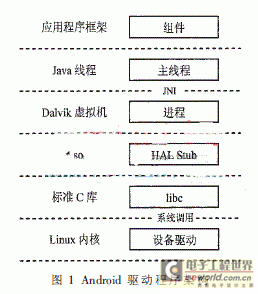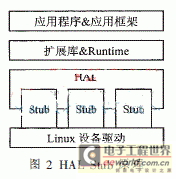The Android system is a Linux-based operating system based on the Linux kernel and Java architecture. It has become a mainstream mobile operating system in a short period of time, and has gradually expanded its application to embedded systems, tablets and netbooks. It has the hardware platform portability of Linux systems, and the development of applications using the Java language brings huge advantages to the application software running on all platforms. Although Android is mainly based on existing technologies, it has great innovation in architecture design. One of its main design goals is to make applications and systems independent of the specific computer architecture and hardware platform, in the device driver design, for existing Linux standard device drivers can continue to use, just for It adds an application layer JNI interface. However, for non-standard devices that are not available in Linux, it is recommended that the driver part of the Linux kernel only do very little interface work. Try to put the main processing of the driver in the upper layer architecture of Android, that is, in the application layer. This article conducts in-depth research on the underlying implementation technology of Android system, including Android hardware abstraction layer and JNI technology implementation. Taking the LED light design display driver on the S3C2440 development board as an example, a design and implementation scheme of a non-standard hardware device driver is proposed.
1 Android system driver architecture
1.1 Driver Hierarchy Architecture
Android is based on Linux, it uses the Linux kernel, but the application is developed in Java language, so the application can not use the system call directly like the normal Linux application when calling the device driver, it must be local to the JNI through the Java virtual machine. The (Native) method uses the device. On the other hand, to become a versatile platform, Android must enhance its portability. This is also the reason for adding a hardware abstraction layer (HAL) in the Android architecture, in order to provide a more advanced package for device calls. Figure 1 shows the Android driver architecture.
HAL Stub exists in the form of a Linux shared library (*.so). In the entire driver architecture, it is a part of the user space in which the device driver runs. It provides an abstract interface for the Dalvik virtual machine to the hardware device. System calls interact with data from drivers in the Linux kernel. In this process, the HAL can process the driver's data, which means that the driver part of the Linux kernel only needs to provide a function to transmit data interface with the hardware device, and the rest of the specific operations can be completed by the HAL.
1.2 Android hardware abstraction layer
Android hardware abstraction layer HAL (Hardware Abstract Layer) in the Android architecture is in the library layer, through this layer, hardware vendors can package the driver source code of some devices in this layer without public source code.
For the analysis in Figure 1, the HAL was designed to separate the application framework from the Linux kernel, allowing Android to use the Linux kernel without relying entirely on the Linux kernel. Of course, the driver is not completely separated from the Linux kernel. Some basic processing must be done by the kernel. HAL only shares some functions of the Linux device driver. As for the proportion of the functions of this part of the driver, there is currently no one. standard.

In the development process of Android system, the implementation of HAL has gradually changed. The old HAL is a modular idea. It is called by the function call method in Runtime at JNI through the shared library. This method has not passed. Encapsulation, that is, the upper application can directly call the hardware. In addition, this method can be used by multiple processes, mapping memory resources in multiple process spaces.
Now HAL proposes a Stub idea. HAL Stub is a proxy concept. Stub is also in the shared library (*.so) format, but the upper application does not call the stub like the dynamic library. The HAL is a combination of a module and a stub. Runtime acquires and operates a stub through a unified interface provided by the module. The Stub provides a callback function for the operation to the HAL. After the Runtime obtains the operation function of the specified module from the HAL, the callback function is called. This is a way of indirect function calls, and the HAL contains multiple stubs. Figure 2 shows the HAL Stib principle.

1.3 Android JNI implementation principle
JNI is an acronym for Java Native Interface, first defined in Sun's Java platform, which allows Java code to interact with other language code. The design purpose of JNI in Android is the same:
(1) Classes in the Java library are not supported when the application needs to interact with the hardware platform;
(2) Local libraries that have been written in other languages ​​allow Java programs to access;
(3) Some functions are implemented more efficiently in lower-level languages, allowing Java programs to call these functions.
The programs or components in the Android application layer are developed in the Java language. These Java codes are compiled into bytecodes in the Dex format, which are executed by the Dalvik virtual machine. When the local library needs to be called during execution, the virtual machine is used. Load these local libraries, and then let the Java function call the functions in the library. The virtual machine is equivalent to a bridge, allowing Java and local libraries to communicate with each other through the standard JNI interface.
The application is executed in the virtual machine, and the function System.loadLibrary( ) is used to notify the virtual machine to load the specified library. For example, the code in the Java code is as follows:
...
System.loadLibrary("sample_jni");
...
The virtual machine will look for the libsample_jni.so library file in the "/system/lib/" directory of the Android file system. After the virtual machine loads libsample_jni.so, the Java code can be executed together with the library file.
These native libraries written in C must follow the specification. When the virtual machine executes the System.loadLibrary() function, it first executes the JNI_OnLoad() function in the local library. The function that this function needs to implement is: return this virtual library to the virtual machine. The JNI version used; initialize the library. If the JNI_OnLoad() function is not implemented in the local library, the virtual machine will default to the oldest JNI version 1.1 using the native library.
The JNI_OnUnload() function corresponds to the load function. When the virtual machine releases the local library, the JNI_OnUnload() function is called to perform resource recovery.
The Java code in the application layer calls the local function through the virtual machine. Generally, it depends on the local function of the virtual machine to find the library. If it needs to be called frequently, it will take more time to affect the efficiency. Here you can register the local functions contained in the gMethods[] table to the virtual machine via the registerNativeMethods() function.
2 Android hardware driver design
Android is an open platform and has a good application prospect in the field of embedded mobile devices. However, there are different hardware support on different devices. To add these hardware applications in Android, it is not simply added in the Linux kernel. Driver modules must also add corresponding support in user space and application frameworks. The following is an example of adding a LED display control driver function to the S3C2440 development board to demonstrate the process of adding new hardware support to the Android platform.
2.1 Hardware Driver Framework
The LED control function is used to switch the LED lights on the development board through the application. In the application layer, the LED control program calls the LED control service (Android Service). The LED control service in the application layer allows the virtual machine to load the LED-controlled local library through JNI, and then obtains the LED Stub from the HAL, which is called by the Stub in the Linux kernel. LED drive. Figure 3 shows the architectural design of the LED control function.
The ball diameter ranges from 0.4mm to 250mm, and the ball diameter tolerance can reach +/-0.001mm, and the product consistency is good. It is widely used for coupling between optical fiber and semiconductor laser, or another optical fiber, or photodetector.
Processing materials mainly include optical glass, quartz, float glass, high borosilicate glass, laser crystal, sapphire, ruby, germanium glass, germanium single crystal, zinc selenide, single crystal silicon, K9 crystal glass, calcium fluoride, silicic acid Salt glass, zinc selenide and cyanide infrared glass lens.
Among them, H-K9L (N-BK7) is crystal clear and has excellent transmittance from visible to near infrared (350-2000nm). It is the most commonly used optical glass for preparing high-quality optical components. When the extra advantage of UV fused silica is not required ( When it has good transmittance and low thermal expansion coefficient in the ultraviolet band), H-K9L is generally selected for optical coating and other fields.
K9 (BK7) has excellent mechanical properties and very low bubbles and impurities, and has good scratch resistance. Due to its stable chemical properties, special grinding and polishing are not required. It is used in many fields such as optoelectronics, microwave technology, diffractive optical element and so on.


H-K9L Half Ball Lens,N-Bk7 Half Ball Lens,H-K9L Optical Half Ball Lens,Hemispherical Lens
Bohr Optics Co.,Ltd , https://www.bohr-optics.com